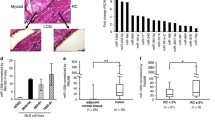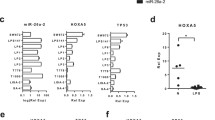Abstract
This study aimed to explore the roles and relationship between FUsed in Sarcoma (FUS)-C/EBP HOmologous Protein (CHOP), microRNA (miR)-486 and cyclin dependent kinase 4 (CDK4) in myxoid liposarcoma, and determined whether FUS-CHOP can regulate proliferation and apoptosis of myxoid liposarcoma cells by regulating miR-486/CDK4 axis. The levels of miR-486, CDK4 and FUS-CHOP in myxoid liposarcoma samples/adjacent normal muscle tissues and myxoid liposarcoma/human adipose-derived stem cell line were evaluated using reverse transcription-quantitative polymerase chain reaction and western blotting. Cell proliferation and apoptosis were performed using 3-(4,5-dimethyl-2-thiazolyl)-2,5-diphenyl-2-H-tetrazolium bromide and flow cytometry, respectively. Furthermore, the apoptosis-related proteins were determined using Western blot assay. We found that miR-486 was down-regulated, FUS-CHOP and CDK4 were up-regulated in myxoid liposarcoma tissues and myxoid liposarcoma cell lines. Moreover, FUS-CHOP-siRNA distinctly suppressed FUS-CHOP level and increased miR-486 levels in 1955/91 cells. Our results demonstrated that knockdown of FUS-CHOP by siRNA inhibited 1955/91 growth, promoted cell apoptosis and enhanced cleaved Caspase3 protein expression. However, all these data were reversed by miR-486 inhibitor. Similarly, compared to mimic control, miR-486 mimic markedly reduced 1955/91 cells growth, induced cell apoptosis and fortified cleaved Caspase3 level, while these results were abolished by CDK4-plasmid. Collectively, our observations clearly suggested that FUS-CHOP regulated myxoid liposarcoma cell proliferation and apoptosis by the regulation of miR-486/CDK4 axis, indicating the potential use of FUS-CHOP-siRNA as a promising therapy for myxoid liposarcoma.





Similar content being viewed by others
References
Abaricia S, Hirbe AC (2018) Diagnosis and treatment of myxoid liposarcomas: histology matters. Curr Treat Options Oncol 19:64
Borjigin N, Ohno S, Wu W et al (2012) TLS-CHOP represses miR-486 expression, inducing upregulation of a metastasis regulator PAI-1 in human myxoid liposarcoma. Biochem Biophys Res Commun 427:355–360
Chen M, Xu ES, Leisenring NH et al (2019) The fusion oncogene FUS-CHOP drives sarcomagenesis of high-grade spindle cell sarcomas in mice. Sarcoma 2019:1340261
Di Martino MT, Guzzi PH, Caracciolo D et al (2015) Integrated analysis of microRNAs, transcription factors and target genes expression discloses a specific molecular architecture of hyperdiploid multiple myeloma. Oncotarget 6:19132–19147
Henze J, Bauer S (2013) Liposarcomas. Hematol Oncol Clin North Am 27:939–955
Jiang M, Li X, Quan X et al (2018a) MiR-486 as an effective biomarker in cancer diagnosis and prognosis: a systematic review and meta-analysis. Oncotarget 9:13948–13958
Jiang J, Gao Q, Gong Y et al (2018b) MiR-486 promotes proliferation and suppresses apoptosis in myeloid cells by targeting Cebpa in vitro. Cancer Med 7:4627–4638
Joseph CG, Hwang H, Jiao Y et al (2014) Exomic analysis of myxoid liposarcomas, synovial sarcomas, and osteosarcomas. Genes Chromosomes Cancer 53:15–24
Lang B, Zhao S (2018) miR-486 functions as a tumor suppressor in esophageal cancer by targeting CDK4/BCAS2. Oncol Rep 39:71–80
Lange S, Banerjee I, Carrion K et al (2019) miR-486 is modulated by stretch and increases ventricular growth. JCI Insight. https://doi.org/10.1172/jci.insight.125507
Laroche-Clary A, Chaire V, Algeo MP, Derieppe MA, Loarer FL, Italiano A (2017) Combined targeting of MDM2 and CDK4 is synergistic in dedifferentiated liposarcomas. J Hematol Oncol 10:123
Li J, Zhou Q, Liang Y et al (2018) miR-486 inhibits PM2.5-induced apoptosis and oxidative stress in human lung alveolar epithelial A549 cells. Ann Transl Med 6:209
Liu Y, Zhang J, Xing C, Wei S, Guo N, Wang Y (2018) miR-486 inhibited osteosarcoma cells invasion and epithelial-mesenchymal transition by targeting PIM1. Cancer Biomark 23:269–277
Livak KJ, Schmittgen TD (2001) Analysis of relative gene expression data using real-time quantitative PCR and the 2-ΔΔCt method. Methods 25:402–408
Nezu Y, Hagiwara K, Yamamoto Y et al (2016) miR-135b, a key regulator of malignancy, is linked to poor prognosis in human myxoid liposarcoma. Oncogene 35:6177–6188
Oikawa K, Tanaka M, Itoh S, Takanashi M, Ozaki T, Muragaki Y, Kuroda M (2012) A novel oncogenic pathway by TLS-CHOP involving repression of MDA-7/IL-24 expression. Br J Cancer 106:1976–1979
Patil N, Ahmed KRS, Abba M, Hendrik LJ, Schwarzbach M, Allgayer H (2014) A mechanistic study on the metastasis inducing function of FUS-CHOP fusion protein in liposarcoma. Int J Cancer 134:2808–2819
Rissland OS, Subtelny AO, Wang M et al (2017) The influence of microRNAs and poly(A) tail length on endogenous mRNA-protein complexes. Genome Biol 18:211
Rodriguez R, Rubio R, Gutierrez-Aranda I, Melen GJ, Elosua C, Garcia-Castro J, Menendez P (2011) FUS-CHOP fusion protein expression coupled to p53 deficiency induces liposarcoma in mouse but not in human adipose-derived mesenchymal stem/stromal cells. Stem Cells 29:179–192
Sun Y, Su Q, Li L, Wang X, Lu Y, Liang J (2017) MiR-486 regulates cardiomyocyte apoptosis by p53-mediated BCL-2 associated mitochondrial apoptotic pathway. BMC Cardiovasc Disord 17:119
Tornin J, Hermida-Prado F, Padda RS et al (2018) FUS-CHOP promotes invasion in myxoid liposarcoma through a SRC/FAK/RHO/ROCK-dependent pathway. Neoplasia 20:44–56
Vos M, Starmans M, Timbergen M et al (2019) Radiomics approach to distinguish between well differentiated liposarcomas and lipomas on MRI. Br J Surg 106:1800–1809
Wang T, Goodman MA, McGough RL, Weiss KR, Rao UN (2014) Immunohistochemical analysis of expressions of RB1, CDK4, HSP90, cPLA2G4A, and CHMP2B is helpful in distinction between myxofibrosarcoma and myxoid liposarcoma. Int J Surg Pathol 22:589–599
Wolff AC (2016) CDK4 and CDK6 inhibition in breast cancer-A new standard. N Engl J Med 375:1993–1994
Wu J, Qian S, Jin L (2019) Prognostic factors of patients with extremity myxoid liposarcomas after surgery. J Orthop Surg Res 14:90
Xiang H, Wang J, Sun MH, Lu L, Shui RH (2005) Zhu XZ [Detection of FUS-CHOP fusion gene in paraffin-embedded tissues and its clinicopathologic significance for myxoid/round cell liposarcomas]. Zhonghua Bing Li Xue Za Zhi 34:28–32
Xing Z, Zhang Z, Gao Y, Zhang X, Kong X, Zhang J, Bai H (2020) The lncRNA LINC01194/miR-486-5p axis facilitates malignancy in non-small cell lung cancer via regulating CDK4. Onco Targets Ther 13:3151–3163
Yu S, Geng S, Hu Y (2018) miR-486-5p inhibits cell proliferation and invasion through repressing GAB2 in non-small cell lung cancer. Oncol Lett 16:3525–3530
Funding
This study was supported by Zhejiang Medical and Health Science and Technology Plan Project (Grant Nos. 2017KY249, 2019KY332).
Author information
Authors and Affiliations
Corresponding author
Ethics declarations
Conflict of interest
The authors declare that they have no conflict of interest.
Additional information
Publisher's Note
Springer Nature remains neutral with regard to jurisdictional claims in published maps and institutional affiliations.
Rights and permissions
About this article
Cite this article
Wu, H., Xia, L. & Xu, H. Role of FUS-CHOP in Myxoid Liposarcoma via miR-486/CDK4 Axis. Biochem Genet 60, 1095–1106 (2022). https://doi.org/10.1007/s10528-021-10151-x
Received:
Accepted:
Published:
Issue Date:
DOI: https://doi.org/10.1007/s10528-021-10151-x




